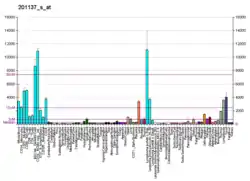HLA-DPB1
HLA class II histocompatibility antigen, DP(W2) beta chain is a protein that in humans is encoded by the HLA-DPB1 gene.
HLA-DPB belongs to the HLA class II beta chain paralogues. This class II molecule is a heterodimer consisting of an alpha (DPA) and a beta chain (DPB), both anchored in the membrane. It plays a central role in the immune system by presenting peptides derived from extracellular proteins. Class II molecules are expressed in antigen presenting cells (APC: B lymphocytes, dendritic cells, macrophages). The beta chain is approximately 26-28 kDa and its gene contains 6 exons. Exon one encodes the leader peptide, exons 2 and 3 encode the two extracellular domains, exon 4 encodes the transmembrane domain and exon 5 encodes the cytoplasmic tail. Within the DP molecule both the alpha chain and the beta chain contain the polymorphisms specifying the peptide binding specificities, resulting in up to 4 different molecules.[3]
References
- ENSG00000230708, ENSG00000229295, ENSG00000226826, ENSG00000215048, ENSG00000223865, ENSG00000230763, ENSG00000237710 GRCh38: Ensembl release 89: ENSG00000236693, ENSG00000230708, ENSG00000229295, ENSG00000226826, ENSG00000215048, ENSG00000223865, ENSG00000230763, ENSG00000237710 - Ensembl, May 2017
- "Human PubMed Reference:". National Center for Biotechnology Information, U.S. National Library of Medicine.
- "Entrez Gene: HLA-DPB1 major histocompatibility complex, class II, DP beta 1".
Further reading
- Mitsunaga S, Kuwata S, Tokunaga K, et al. (1992). "Family study on HLA-DPB1 polymorphism: linkage analysis with HLA-DR/DQ and two "new" alleles". Hum. Immunol. 34 (3): 203–11. doi:10.1016/0198-8859(92)90113-2. PMID 1358867.
- Marsh SG, Bodmer JG (1993). "HLA class II nucleotide sequences, 1992". Tissue Antigens. 40 (5): 229–43. doi:10.1111/j.1399-0039.1992.tb02050.x. PMID 1362295.
- Eiermann TH, Uhl S, Fakler J, Goldmann SF (1992). "A novel HLA-DPB1 sequence, DPB1*2301". Tissue Antigens. 40 (2): 108–10. doi:10.1111/j.1399-0039.1992.tb01969.x. PMID 1412416.
- Korioth F, Hartung K, Deicher H, Frey J (1992). "A new HLA-DPB1 allele from a patient with systemic lupus erythematosus". Tissue Antigens. 39 (4): 216–9. doi:10.1111/j.1399-0039.1992.tb01938.x. PMID 1529429.
- de Koster HS, Kenter MJ, D'Amaro J, et al. (1991). "Positive correlation between oligonucleotide typing and T-cell recognition of HLA-DP molecules". Immunogenetics. 34 (1): 12–22. doi:10.1007/BF00212307. PMID 1713190. S2CID 21845822.
- Vanderbeeken YE, Duchateau J, Colle H, et al. (1991). "Modulation of the HLA class II antigen at a molecular level by maternal serum among cord blood cells and unrelated lymphocytes". Arch. Gynecol. Obstet. 248 (4): 199–209. doi:10.1007/BF02390359. PMID 1832848. S2CID 25184115.
- Piatier-Tonneau D, Gastinel LN, Amblard F, et al. (1991). "Interaction of CD4 with HLA class II antigens and HIV gp120". Immunogenetics. 34 (2): 121–8. doi:10.1007/BF00211424. PMID 1869305. S2CID 10116507.
- Rosenstein Y, Burakoff SJ, Herrmann SH (1990). "HIV-gp120 can block CD4-class II MHC-mediated adhesion". J. Immunol. 144 (2): 526–31. PMID 1967269.
- Bowman MR, MacFerrin KD, Schreiber SL, Burakoff SJ (1991). "Identification and structural analysis of residues in the V1 region of CD4 involved in interaction with human immunodeficiency virus envelope glycoprotein gp120 and class II major histocompatibility complex molecules". Proc. Natl. Acad. Sci. U.S.A. 87 (22): 9052–6. doi:10.1073/pnas.87.22.9052. PMC 55099. PMID 1978941.
- Bugawan TL, Begovich AB, Erlich HA (1990). "Rapid HLA-DPB typing using enzymatically amplified DNA and nonradioactive sequence-specific oligonucleotide probes". Immunogenetics. 32 (4): 231–41. doi:10.1007/BF00187094. PMID 2242906. S2CID 39873046.
- Lair B, Alber C, Yu WY, et al. (1988). "A newly characterized HLA-DP beta-chain allele. Evidence for DP beta heterogeneity within the DPw4 specificity". J. Immunol. 141 (4): 1353–7. PMID 2456351.
- Bugawan TL, Horn GT, Long CM, et al. (1988). "Analysis of HLA-DP allelic sequence polymorphism using the in vitro enzymatic DNA amplification of DP-alpha and DP-beta loci". J. Immunol. 141 (11): 4024–30. PMID 2460556.
- Begovich AB, Bugawan TL, Nepom BS, et al. (1990). "A specific HLA-DP beta allele is associated with pauciarticular juvenile rheumatoid arthritis but not adult rheumatoid arthritis". Proc. Natl. Acad. Sci. U.S.A. 86 (23): 9489–93. doi:10.1073/pnas.86.23.9489. PMC 298522. PMID 2512583.
- Scholl P, Diez A, Mourad W, et al. (1989). "Toxic shock syndrome toxin 1 binds to major histocompatibility complex class II molecules". Proc. Natl. Acad. Sci. U.S.A. 86 (11): 4210–4. doi:10.1073/pnas.86.11.4210. PMC 287420. PMID 2542966.
- Clayton LK, Sieh M, Pious DA, Reinherz EL (1989). "Identification of human CD4 residues affecting class II MHC versus HIV-1 gp120 binding". Nature. 339 (6225): 548–51. doi:10.1038/339548a0. PMID 2543930. S2CID 4246781.
- Lee JS, Sartoris S, Briata P, et al. (1989). "Sequence polymorphism of HLA-DP beta chains". Immunogenetics. 29 (5): 346–9. doi:10.1007/BF00352845. PMID 2714855. S2CID 13414587.
- Compagnone-Post P, Turco E, Robinson C, Trucco M (1988). "The beta-chains of DP4 molecules from different haplotypes are encoded by the same gene". Genomics. 2 (1): 8–13. doi:10.1016/0888-7543(88)90103-6. PMID 2838415.
- Diamond DC, Sleckman BP, Gregory T, et al. (1988). "Inhibition of CD4+ T cell function by the HIV envelope protein, gp120". J. Immunol. 141 (11): 3715–7. PMID 2846691.
- Ando A, Inoko H, Kimura M, et al. (1987). "Isolation and allelic polymorphism of cDNA clones and genomic clones of HLA-DP heavy and light chains". Hum. Immunol. 17 (3): 355–67. doi:10.1016/0198-8859(86)90286-7. PMID 2878910.
- Kelly A, Trowsdale J (1985). "Complete nucleotide sequence of a functional HLA-DP beta gene and the region between the DP beta 1 and DP alpha 1 genes: comparison of the 5' ends of HLA class II genes". Nucleic Acids Res. 13 (5): 1607–21. doi:10.1093/nar/13.5.1607. PMC 341099. PMID 2987832.


